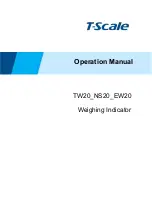
CS616 and CS625 Water Content Reflectometers
18
volumetric water content measurement can be optimized by characterizing
the probe response in the specific medium to be measured. The result is a
specific calibration equation for a particular medium.
The precision and the resolution of the water content reflectometer
measurement are not affected by attenuating media. Both precision and
resolution are better than 0.1% volumetric water content.
8.2.2
User-Derived Calibration Equation
The probe output response to changing water content is well described by a
quadratic equation, and, in many applications, a linear calibration gives
required accuracy.
Quadratic form:
2
2
1
0
C
C
C
v
with
v
, the volumetric water content (m
3
m
–3
);
,
the CS616/CS625 period
(microseconds); and C
n
, the calibration coefficient. The standard
calibration coefficients are derived from factory laboratory measurements
using curve fitting of known volumetric water content to probe output
period.
Linear form:
1
0
C
C
v
with
v
, the volumetric water content (m
3
m
-3
);
,
the water content
reflectometer period (microseconds); C
o
, the intercept; and C
1
, the slope.
Two data points from careful measurements can be enough to derive a
linear calibration. A minimum of 3 data points is needed for a quadratic.
With 3 evenly spaced water contents covering the expected range, the
middle water content data point will indicate whether a linear or quadratic
calibration equation is needed.
The calibration function describing the CS616/CS625
response to changing water content is always concave up. If
calibration data suggests a different shape, there may be a
problem with the data or method.
8.2.3
Collecting Laboratory Data for Calibration
Water content reflectometer data needed for CS616/CS625 calibration are
the CS616/CS625 output period (microseconds) and an independently
determined volumetric water content. From this data, the probe’s response
to changing water content can be described by a quadratic calibration
equation of the form
2
2
1
0
C
C
C
v
with
v
being the volumetric water content (m
3
m
–3
);
, the CS616 period
(microseconds); and C
n
, the calibration coefficient (n = 0..2).
NOTE
















































